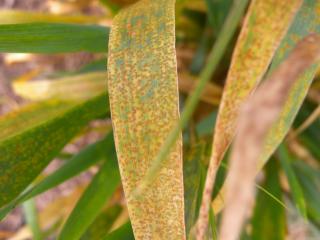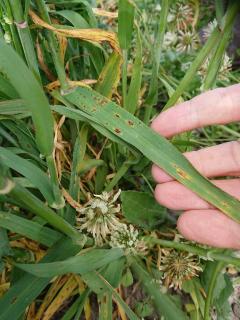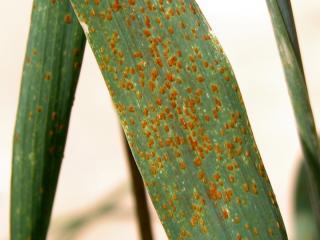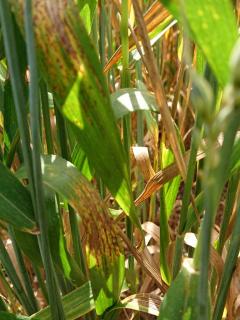Weather conditions are still conducive for wheat and barley diseases down south. Have you started considering disease management strategies for 2019?
Barley leaf rust
- South Stirlings
- Borden
Plant pathologist Kithsiri Jayasena (DPIRD) has reported that Baudin trap plants near DPIRD’s spore trap trial site at Borden are showing barley leaf rust (BLR). Kith has also seen BLR in regrowth Oxford barley plants near South Stirlings.
For more information on BLR refer to the department’s Diagnosing barley leaf rust page.
Barley spot-type and net-type net blotches
- Frankland River
- South Stirlings
- Borden
Plant Pathologist Kithsiri Jayasena (DPIRD) reports that both spot-type net blotch (STNB) and net-type net blotch (NTNB) have started to flare up on RGT Planet barley near; Frankland River and Borden and in Flinders barley and regrowth Oxford barley plants near South Stirling.
For further information on symptoms and management of STNB and NTNB refer to DPIRD’s Managing spot type net blotch in continuous barley and Managing net-type net blotch of barley in Western Australia pages.
Wheat leaf rust
- Esperance
Plant pathologist Andrea Hills (DPIRD) reports that wheat leaf rust is getting going around Esperance in the warmer medium to low rainfall areas.
Andrea advises that with most crops post flowering, it’s not worth controlling and potentially dangerous with the harvest with-holding periods being 4-5 weeks depending on the product.
For more information see DPIRD’s Diagnosing leaf rust of wheat page.
Wheat septoria
- Kendenup
Plant pathologist Kithsiri Jayasena (DPIRD) has found Septoria on Calingiri wheat near Kendenup.
For more information see DPIRD’s Diagnosing septoria nodorum of wheat page.
Current control options for cereal diseases
In general sprays after cereal plants are flowering (into grain fill) are less likely to provide economic return, particularly if warmer drier conditions are possible in next few weeks. It is also important to remember issues around withholding periods associated with fungicides, this information is available on product labels.
For fungicide information refer to DPIRD’s Registered foliar fungicides for cereals in WA page.
Disease management strategies for 2019
Growers need to monitor the upcoming summer green bridge for disease so that timely action can be taken to identify the pathogen and limit the spread and build-up of inoculum.
It is crucial that growers kill weeds and crop volunteers, including those along fencelines, prior to the start of the cropping program to reduce potential disease outbreaks.
Ideally there needs to be a break (a fallow period) of at least two weeks free of vegetation capable of hosting disease prior to sowing. To achieve this, the weeds and volunteers should be sprayed with a herbicide at least four to six weeks before sowing, to ensure weeds are completely dead at planting.
Alternatives to herbicides are to heavily graze or cultivate weeds and crop volunteers which will reduce their potential as a ‘green bridge’ or host of diseases and pests.
In addition to managing the green bridge growers can;
- Sow clean seed. There have been reports of loose smut in barley this season and this disease is carried as a small colony of fungus inside seed. Using certified seed treated with seed dressing fungicide is recommended for 2019 for managing smut and other cereal disease.
- Get to know the latest disease ratings of your varieties and plan accordingly. Use adult plant resistant varieties. Crop variety guides are available for all grains on the DPIRD website, which document the disease susceptibility for each variety.
- Consider applying in-furrow or seed dressing fungicides to reduce your risk of early infection of diseases. For more information see the department's Seed dressing and in-furrow fungicides for cereals in Western Australia.
- In case of early disease outbreak, budget for early foliar fungicide sprays where upfront fungicides are not used. For more information visit the department's Registered foliar fungicides for cereals in Western Australia.
- Reduce exposure to stubble borne diseases through rotation and careful paddock planning (to avoid sowing on or adjacent to infected stubble) or stubble management (such as grazing, windrowing, baling, incorporating or burning).
- Earlier sown crops may be more at risk of some foliar diseases such as powdery mildew, net blotches of barley, septoria and yellow spot of wheat so consider later sowing of susceptible varieties and at risk paddocks, or at least plan to monitor earliest sown paddocks closely for disease.
For more information see DPIRD's Control of green bridge for pest and disease management page and the Grains Research and Development Corporation's (GRDC) Green bridge fact sheet.
For more cereal disease information contact Kithsiri Jayasena, Plant Pathologist, Albany on +61 (0)8 9892 8477, Geoff Thomas, Plant Pathologist, South Perth on +61 (0)8 9368 3262 or Andrea Hills, Plant Pathologist, Esperance on +61 (0)8 9083 1144 or Ciara Beard, Plant Pathologist, Geraldton on +61 (0)8 9956 8504.




